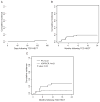CD34-Selected Allogeneic Hematopoietic Stem Cell Transplantation for Patients with Relapsed, High-Risk Multiple Myeloma
- PMID: 26325439
- PMCID: PMC4975432
- DOI: 10.1016/j.bbmt.2015.08.025
CD34-Selected Allogeneic Hematopoietic Stem Cell Transplantation for Patients with Relapsed, High-Risk Multiple Myeloma
Abstract
We report results of a retrospective analysis of 44 patients with relapsed and high-risk multiple myeloma (MM) undergoing allogeneic CD34-selected hematopoietic stem cell transplantation (HSCT) from HLA-compatible donors. Patients had multiply relapsed disease including relapse at <15 months after autologous transplantation and most patients (28 of 44; 65%) also had high-risk cytogenetics. Before transplantation, patients received busulfan (.8 mg/kg × 10 doses), melphalan (70 mg/m(2) × 2 days), fludarabine (25 mg/m(2) × 5 days), and rabbit antithymocyte globulin (2.5 mg/kg × 2 days). Patients with 10/10 HLA- matched donors were treated prophylactically with low doses of donor lymphocyte infusions (.5 to 1 × 10(6) CD3(+)/kg) starting 4 to 6 months after CD34-selected HSCT. Acute (grade II to IV) graft-versus-host disease (GVHD) and transplantation-related mortality at 12 months were 2% and 18%, respectively. Chronic GVHD was not observed in any patient. Overall and progression-free survival at 2 years were 54% and 31%, respectively. By multivariate analyses, the outcomes of CD34-selected HSCT were influenced by presence of extramedullary disease, disease status before CD34-selected HSCT, and age. This study demonstrates notable safety and efficacy of CD34-selected HSCT in patients with multiply relapsed MM, including those with high-risk cytogenetics.
Keywords: Adoptive immunotherapy; D34-selected hematopoietic stem cell transplantation; Relapsed high-risk multiple myeloma.
Copyright © 2016 American Society for Blood and Marrow Transplantation. Published by Elsevier Inc. All rights reserved.
Conflict of interest statement
The authors have no conflicts of interest to disclose.
Figures





Similar articles
-
Presalvage International Staging System Stage and Other Important Outcome Associations in CD34+-Selected Allogeneic Hematopoietic Stem Cell Transplantation for Multiple Myeloma.Biol Blood Marrow Transplant. 2020 Jan;26(1):58-65. doi: 10.1016/j.bbmt.2019.08.023. Epub 2019 Sep 5. Biol Blood Marrow Transplant. 2020. PMID: 31493537 Free PMC article. Clinical Trial.
-
Feasibility of second hematopoietic stem cell transplantation using reduced-intensity conditioning with fludarabine and melphalan after a failed autologous hematopoietic stem cell transplantation.Transplant Proc. 2010 Nov;42(9):3723-8. doi: 10.1016/j.transproceed.2010.09.005. Transplant Proc. 2010. PMID: 21094846
-
Modified conditioning regimen busulfan-cyclophosphamide followed by allogeneic stem cell transplantation in patients with multiple myeloma.Chin Med J (Engl). 2007 Mar 20;120(6):463-8. Chin Med J (Engl). 2007. PMID: 17439737
-
Allogeneic hematopoietic stem cell transplantation (HSCT) after reduced intensity conditioning.Transfus Apher Sci. 2011 Apr;44(2):205-10. doi: 10.1016/j.transci.2011.01.019. Epub 2011 Feb 22. Transfus Apher Sci. 2011. PMID: 21345734 Review.
-
Allogeneic hematopoietic stem cell transplantation for multiple myeloma: curative but not the standard of care.Curr Opin Oncol. 2012 Nov;24(6):720-6. doi: 10.1097/CCO.0b013e328358f619. Curr Opin Oncol. 2012. PMID: 22960558 Review.
Cited by
-
Allograft for Myeloma: Examining Pieces of the Jigsaw Puzzle.Front Oncol. 2017 Dec 11;7:287. doi: 10.3389/fonc.2017.00287. eCollection 2017. Front Oncol. 2017. PMID: 29322027 Free PMC article. Review.
-
Cellular and vaccine immunotherapy for multiple myeloma.Hematology Am Soc Hematol Educ Program. 2016 Dec 2;2016(1):521-527. doi: 10.1182/asheducation-2016.1.521. Hematology Am Soc Hematol Educ Program. 2016. PMID: 27913524 Free PMC article. Review.
-
CARs and other T cell therapies for MM: The clinical experience.Best Pract Res Clin Haematol. 2018 Jun;31(2):147-157. doi: 10.1016/j.beha.2018.03.002. Epub 2018 Mar 27. Best Pract Res Clin Haematol. 2018. PMID: 29909915 Free PMC article. Review.
-
Prognostic Factors for Postrelapse Survival after ex Vivo CD34+-Selected (T Cell-Depleted) Allogeneic Hematopoietic Cell Transplantation in Multiple Myeloma.Biol Blood Marrow Transplant. 2020 Nov;26(11):2040-2046. doi: 10.1016/j.bbmt.2020.07.016. Epub 2020 Jul 23. Biol Blood Marrow Transplant. 2020. PMID: 32712326 Free PMC article.
-
Allogeneic Hematopoietic Stem Cell Transplantation in Refractory Multiple Myeloma-A Retrospective Multicenter Analysis.Eur J Haematol. 2025 Mar;114(3):423-428. doi: 10.1111/ejh.14346. Epub 2024 Nov 13. Eur J Haematol. 2025. PMID: 39535309 Free PMC article.
References
-
- Kyle RA, Rajkumar SV. Multiple myeloma. N Engl J Med. 2004;351(18):1860–1873. - PubMed
-
- Smith BD, Smith GL, Hurria A, Hortobagyi GN, Buchholz TA. Future of cancer incidence in the United States: burdens upon an aging, changing nation. J Clin Oncol. 2009;27(17):2758–2765. - PubMed
-
- Rajkumar S, Fonseca R, Lacy M, et al. Abnormal cytogenetics predict poor survival after high-dose therapy and autologous blood cell transplantation in multiple myeloma. Bone Marrow Transplant. 1999;24(5):497–503. - PubMed
-
- Gahrton G, Tura S, Ljungman P, et al. Allogeneic bone marrow transplantation in multiple myeloma. European Group for Bone Marrow Transplantation. N Engl J Med. 1991;325(18):1267–1273. - PubMed
MeSH terms
Substances
Grants and funding
LinkOut - more resources
Full Text Sources
Other Literature Sources
Medical
Research Materials

